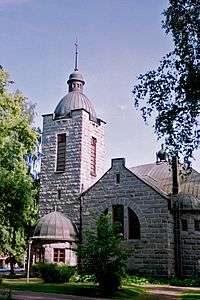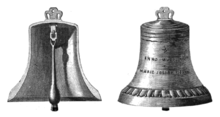Juutila Foundry
| General partnership[1] | |
| Industry | Foundry |
| Genre | Sand casting foundry |
| Founded | 1881 |
| Founder | Mr Heikki Juutilainen |
| Headquarters | Kaavi, Finland |
Key people | Mr Eljas Juutilainen |
| Products | Church bells, jingle bells, sleight bells, reliefs, grave crosses, family crests, business gifts |
| Website | Juutila Foundry |
| Established | 2004 |
|---|---|
| Location | Kaavi, Finland |
| Coordinates | 63°04′18″N 28°26′25″E / 63.071667°N 28.440278°E |
| Website | Juutila Foundry Museum |
Juutila Foundry is the oldest still working bell foundry in Finland. Juutila foundry was founded in 1881.
Juutila Foundry (Juutilan valimo or Metallivalimo H & E Juutilainen in Finnish) is situated in a village of Vehkalahti in Kaavi, Northern Savonia.
Juutila Foundry Museum is in the old foundry building. It is a unique museum of its kind in the Nordic countries introducing the traditional sand casting method of the foundry.[2]
History
Juutila Foundry casts products out of bronze and brass. The foundry can make single pieces up to 500 kg (about 1100 lb).
The different kinds of bells and mortars and pestles were one of the main products in the early history of the foundry. The products of Juutila were originally sold as far as in Vyborg and Sortavala in Karelia.[3] Some of the products found their way even to St. Petersburg.[4]
In the 1940s the foundry made a large number of school bells. Five men were working in the foundry then. In the 1960s Juutila Foundry started to make church bells, which became the main products in the 1980s and 1990s.[5] Nowadays Juutila Foundry manufactures about half a dozen church bells annually.[6]
Foundry worked the first hundred years in an old workshop. The new foundry building of brick was built in 1982.
Craftsmanship since 1881
Nowadays Mr Eljas Juutilainen carries on the tradition of his forebears by sand casting. The craft of casting and foundry work came to Juutila farm with Juutilainen's grandfather's uncle from nearby Juankoski ironworks. The history of Juutila Foundry dates back to 1881.
Mr Eljas Juutilainen is a third-generation craftsman. He has been working at the foundry more than 40 years. Juutilainen was awarded Finnish State Award of Industrial Arts in 1975.[4][6][7] Finnish Chambers of Commerce has given him Golden Medal of Merit. Cross of Merit of the Order of the Lion of Finland was awarded him by President of Finland.[8]
Products
Juutila Foundry makes many kinds of bells (church bells, jingle bells, sleigh bells), candlesticks, reliefs, grave crosses, business gifts etc.[7]
In the 21st century Juutila Foundry has been casting also the medallions of Cranbrook chairs (new production) designed by Eliel Saarinen.[8][9]
Commissions

Juutila Foundry has manufactured church bells e.g. to these churches in Finland:
- Hanko[6]
- Hartola, Hartola Church
- Iisalmi
- Juankoski, Church of the Resurrection of Christ (Ylösnousemuksen kirkko)
- two brass bells (since 1990)
- bigger bell: diameter about 77 cm (ca 30 inches), weight 265 kg (about 584 pounds), pitch B
- smaller bell: diameter about 60 cm (ca 24 inches), weight 135 kg (about 298 pounds), pitch D[10]
- Juankoski, Juankoski Orthodox Church[11]
- Kaavi, Luikonlahti Orthodox Chapel[12]
- Kangasala, Sahalahti Church
- Kempele, Kempele Church
- Kiuruvesi, Lapinsalo Church[13]
- Kontiolahti, Kontiolahti Church[14]
- Lahti, Mukkula Parish Centre
- Lapinlahti, Alapitkä Church[15]
- Lappeenranta, Orthodox church of Lappeenranta [16][17]
- bronze bell, weight 180 kg
- Nilsiä, Murtolahti Chapel[18][19]
- brass bell (since 2005)
- diameter about 41 cm (about 16 inches)[10]
- Nivala, Karvoskylä Chapel[20]
- Nokia, Pinsiö Church[21]
- Pyhäjoki, Pyhäjoki Church[22]
- Pyhäjärvi, Pyhäjärvi Church
- Ristijärvi, Ristijärvi Church
- Savonlinna, Haukiniemi Orthodox Chapel
- Utsjoki, Nuorgam[8]
Venehjärvi Orthodox Chapel in Republic of Karelia, Russia,[25] and church in Koltuši (Колтуши), Russia, have also bells from Juutila Foundry. They have exported Juutila bells also to Australia,[8] Bolivia, Kenya, Namibia, Senegal, Tanzania and Uruguay.[4][6][7]
Juutila Foundry Museum
In the beginning of new millennium they decided to establish a foundry museum to preserve foundry's history. By the expertise of the Finnish National Board of Antiquities the items of the old foundry were counted. They listed almost 2 000 objects from the foundry.[4]
The old foundry got a new location in the other side of the yard and it became a museum introducing especially the traditional sand casting method of the foundry.[2][26]
Juutila Foundry Museum was opened in 2004. It is open in summer.[2][5]
References
- ↑ Taloussanomat, January 13, 2013
- 1 2 3 Juutila Foundry, Municipality of Kaavi, January 12, 2013
- ↑ Historic ironworks in Savo, 1999
- 1 2 3 4 Salminen, Anja: Valumestari Eljaksen kellot kaikuvat jouluna kautta maan, Taloussanomat, December 24, 1998, (Finnish)
- 1 2 Pohjois-Savon kulttuuriympäristöselvitys, Kaavi, Pohjois-Savon liitto, 2009 (Finnish)
- 1 2 3 4 Kaavin kellot kumajavat Hangossa asti, Savon Sanomat (newspaper), March 7, 2012, page 3 (Finnish)
- 1 2 3 Leskelä, Hilkka: Kaskenviertäjien ja kivenraivaajien Kaavi, Jyväskylä, 1998, ISBN 952-910-451-0 (Finnish)
- 1 2 3 4 Molempikätisyys, lehmän hermot ja pikkutarkkuus ovat hyvän valajan ominaisuuksia, Koillis-Savo (newspaper), November 19, 2015, page 11 (Finnish)
- ↑ Tetrimäki: Eliel Saarinen Collection, Boyschool Chair and Armchair
- 1 2 Lappalainen, Katja, Arkipäiväisistä katseilta suojatuiksi – Nilsiän emäseurakunnan alueen kirkonkellot, pdf, 2006, University of Jyväskylä, January 12, 2013 (Finnish)
- ↑ Juankosken ortodoksinen kirkko, Ortodoksi.net, January 12, 2013 (Finnish)
- ↑ Luikonlahden ortodoksinen tšasouna, Ortodoksi.net, January 12, 2013 (Finnish)
- ↑ Lapinsalon hautausmaa, November 16, 2013 (Finnish)
- ↑ Seurakunnan pääkirkko, Kontiolahden seurakunta, January 12, 2013 (Finnish)
- ↑ Alapitkän kirkko, January 12, 2013 (Finnish)
- ↑ Etelä-Saimaa: Ortodoksikirkko saa lahjoituksen uuden kirkonkellon, September 30, 2016 (Finnish)
- ↑ Yle: Kellonsoittajalla jo seitsemän kelloa – ortodoksikirkon kaikki kellot soivat käsipelillä, October 14, 2016 (Finnish)
- ↑ Murtolahden kyläyhdistys, Murtolahden kyläyhdistys, January 12, 2013 (Finnish)
- ↑ Murtolahden siunauskappeli, Nilsiän seurakunta, January 12, 2013 (Finnish)
- ↑ Karvoskylä Village, Facebook (Finnish)
- ↑ Pinsiöön rakennetaan kellotapuli talkoilla, December 22, 2011, Yle, January 12, 2013 (Finnish)
- ↑ Kotikirkkomme, December 17, 2005, Raahelainen (newspaper), January 12, 2013 (Finnish)
- ↑ Toimitilat, Kirkko ja kellotapuli, Ristijärven seurakunta, January 13, 2014 (Finnish)
- ↑ Ristijärven kirkko 200 vuotta - Ristijärvelle rakennettiin kirkko kesällä 1807, Ristijärvi tiedottaa, pdf, 2007, Ristijärven kunta, January 13, 2014 (Finnish)
- 1 2 "Haukiniemen tsasouna (Haukiniemi Orthodox Chapel)" (in Finnish). Haukiniemen kulttuurikyläyhdistys ry. 15 October 2013. Retrieved 15 October 2013.
- ↑ Kaavi, Juutilan kellovalimon siirto, Finnish National Board of Antiquities, January 12, 2013 (Finnish)
See also
- Photo: Moving old foundry to new location (building Foundry Museum)
- Photo: Juutila's horse bell, diameter 10,7 cm (about 4 inches), from Museum of Lieksa (Pielisen museo)
